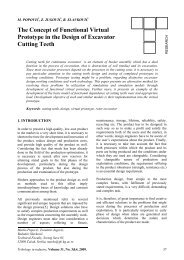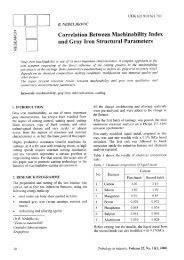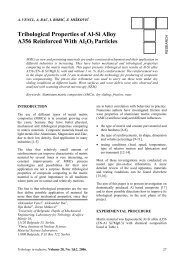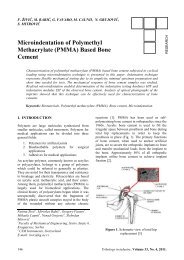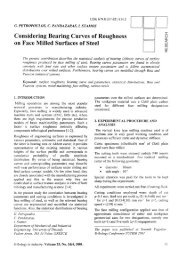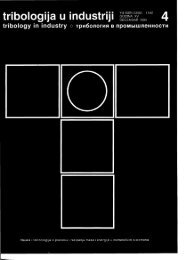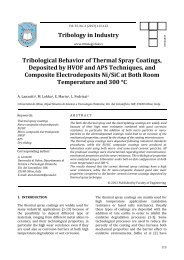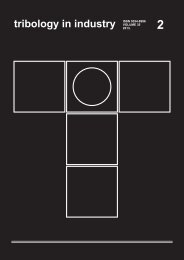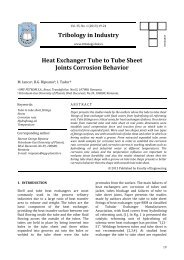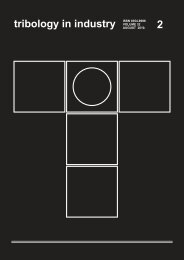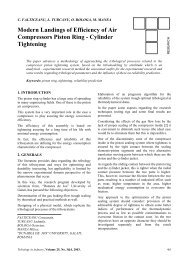No. 1, 1998 - Tribology in Industry
No. 1, 1998 - Tribology in Industry
No. 1, 1998 - Tribology in Industry
You also want an ePaper? Increase the reach of your titles
YUMPU automatically turns print PDFs into web optimized ePapers that Google loves.
2. METHOI} FOR DETERMINING THE<br />
FRICTION FOITCE ON FI-ANK<br />
SUR.FACE<br />
Fig 2. The rea! area of cotltlct<br />
F,F' = Fo, + F,p1+ F-1,n 6)<br />
The specialty literature [1...12] underi<strong>in</strong>es that <strong>in</strong> order<br />
to determ<strong>in</strong>e <strong>in</strong> practice the friction force, the most used<br />
relations rema<strong>in</strong> those based on Coulomb's dry friction<br />
laws (relations 4 and 5), or those written as functiotrs of<br />
the force distribution on the contact surface (relations 6<br />
and / l.<br />
tl<br />
P = Hr. oy.f. acdot C11 (4)<br />
F' trto' F''; (5)<br />
F = ,r,or' l' lr',' cos r1 6)<br />
Ac<br />
F' = r,,. l. iL . cr,t n (7)<br />
'^<br />
.slnu<br />
So, the calculation of the friction forces, us<strong>in</strong>g the relations<br />
mentionecl abcrve aild based on the value of the<br />
friction coefficient, the plastic deibrmation force and the<br />
area of the contact surface, is difficult and imprecise, and<br />
that's why it is preferable to cleterm<strong>in</strong>e these fbrces by<br />
experiments. There are viirious constructions of devices<br />
used for experiment.rl cleterrn<strong>in</strong>ations of the forces and<br />
of the friction coefficient <strong>in</strong> crttt<strong>in</strong>g. The analysis of these<br />
devices sl.lowed that the dynarrrometric constrttctitlns<br />
used are very complicated, and sometimes they have not<br />
the reliability and the rigiclity necessary for the researcher'scope.<br />
That's rvh,v they are used onlv for nclrmal<br />
cutt<strong>in</strong>g sPeeds.<br />
This paper presents a me thocl for deteim<strong>in</strong><strong>in</strong>g the ftlrce<br />
and the friction coefficient betrveen tire tool and the<br />
mach<strong>in</strong>ed piece. and the experimental results obta<strong>in</strong>ed<br />
<strong>in</strong> semi-orthoqonal turtiug, nodeled as accord<strong>in</strong>g to [5]<br />
Tlibologt itt <strong>in</strong>d*stry, Volume 20, <strong>No</strong>' 1, <strong>1998</strong>.<br />
Determ<strong>in</strong><strong>in</strong>g the friction force on tlie flank surface <strong>in</strong><br />
that case was macle with an observation: the chip's fornr<strong>in</strong>g<br />
clisrippears witen the clepth (l) of metai's layer <strong>in</strong><br />
contact with the tool is equal to the elastic deformation<br />
(Ar), (c:A*) [3, a]. In that moment. on the curves obta<strong>in</strong>ed<br />
bv experiments (figure 3), for the conrponents Foo<br />
I;o\; I;,,2 of the cutt<strong>in</strong>g foi'ce, a correspond<strong>in</strong>g threshtlld<br />
appeiirs.<br />
It is obvious tliet *'hen the feed is suddenly cut off' the<br />
folce decreases rtntil a certa<strong>in</strong> value is reacl-red and then<br />
the variatiorr is illoirg the arc c-tl or a land<strong>in</strong>g g-h' The<br />
length of the ilrc tlr lancl<strong>in</strong>g clepends on the paper's feed,<br />
but the nromeilt of the appearance (po<strong>in</strong>ts I and g)<br />
correspontis trl feed's siop (figure 4).<br />
Admitt<strong>in</strong>g that the cutt<strong>in</strong>g does tiot take place at a deptlt<br />
tt=Lr, it results that the friction force on ihe contact<br />
surface with the mach<strong>in</strong>ed piece czln tle considered as<br />
be<strong>in</strong>g the force correspond<strong>in</strong>g to po<strong>in</strong>ts d and g on the<br />
experimental curves. The correspond<strong>in</strong>g value is the friction<br />
force ttn tire flank sur-face' correspond<strong>in</strong>g to the filst<br />
rotatir-rn after the feecl's stop. We can see that the arc<br />
(lanct<strong>in</strong>g) appears to all curyes, so it means that the<br />
friction force t-.n the flank surface is consists of three<br />
cor.nponents {,, 1r, ir nC -F, and t}re resultant force can be<br />
obta<strong>in</strong>ed by relation (8).<br />
I:' .- ^ii-a rj: i F,'<br />
3. PHYSICAL-GEONIETRICAL MODBL<br />
}-OIT DETERMINING THE NORMAL<br />
FORCE (F'x) T0 THE FLANK SURFACE<br />
The phi;sic:rl atlcl <strong>in</strong>athetlaticirl model proposed for deterui<strong>in</strong><strong>in</strong>g<br />
the nt-rrrriirl forcii to the flank surface 11ry; is<br />
clescribccl <strong>in</strong> Ii,.s], for high speed cutt<strong>in</strong>g' For a crttt<strong>in</strong>g<br />
tooth with a seneral shape eclge, relative to the MXYZ<br />
system, figure 5, thcre were established (based on analytical<br />
and m;rtrlx geonetry technics) the relations (9)<br />
between the compr;ncnts of the friction force (F), the<br />
plastic defonnation force (I7g) or.r the rake surfztce, the<br />
conlponents iI'') ancl (I',y) on the flank sur{ace, the<br />
<strong>in</strong>ertial co<strong>in</strong>pi)llent (/i) and the experirnentally measurairle<br />
cttmponents 1.,,o I'-ou I'-ur.<br />
Ar ltt C1 r N1l<br />
At ll' - C' r ,\' l'<br />
.'tt s, C.3 't'1l<br />
This systenr {9) can be solved itl trvo situations. <strong>in</strong> tirese<br />
CASCS;<br />
(6)<br />
'il-l:ll (e,<br />
;^'] L.4i<br />
1l



